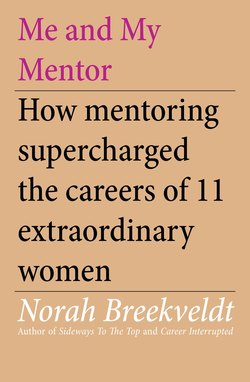Читать книгу Me and My Mentor - Norah Breekveldt - Страница 9
На сайте Литреса книга снята с продажи.
ОглавлениеIntroduction
‘I think the key is for women not to set any limits.’
— Martina Navratilova, former world number 1 tennis player.
Kate found it challenging returning to work from maternity leave, and would have felt satisfied returning to a job in her comfort zone. She said if it weren’t for her mentor Adam challenging her thinking she could have missed out on taking one of the best jobs she’s ever had.
As Sophie’s mentor, Jodi has been her greatest cheerleader as well as her toughest critic. Jodi reminds other women to be kind and generous to those coming up behind them and to remember how tough it was when they were younger and striving to succeed.
Wayne believes he is a better football coach and a more mature, grounded and balanced person from having coached women and having a female mentor, Chyloe.
Bec was sixteen years old when she first met Jerril and got a glimpse of what life as a performing artist could be. Jerril knew she had found a kindred spirit in Bec and committed herself to guiding Bec through the difficult professional decisions and life choices a performing artist must inevitably make.
These are just a few of the stories explored in Me and My Mentor, some of them never before told. The experiences and reflections of these women move our thinking beyond descriptions of theory and best practice. They reveal stories of real-life experiences with the voices of women whose mentors were a constant source of inspiration, personal growth and perspective.
Changing hearts and minds one story at a time
The lessons and insights contained in these stories can be applied to both men and women, yet women have a special need to be mentored because of the inequities they continue to experience in the workplace. While women continue to outperform men educationally and are more likely to complete tertiary studies than men1 the leadership gap stubbornly remains. The pipeline of women into management roles is strengthening, yet women continue to be under-represented at the top, with five out of every six CEO roles still being held by men.2 Just as disappointingly, the pay gap has been hovering at between fifteen percent and nineteen percent over the last two decades, but increasing towards management level and reaching 28.8 percent for managers3. Mentoring is one way to start changing these numbers.
What is mentoring?
Textbook definitions often describe mentoring as a professional relationship between an older, wiser, senior mentor sharing their work experiences and wisdom with a younger, junior and inexperienced mentee. This concept has its roots in Greek mythology, when Odysseus, commencing his journey to Troy, entrusted his house and his son’s education to his friend, Mentor. ‘Tell him all you know,’ Odysseus said, and from then the definition of mentoring was firmly established.
However, the real-life experiences of mentors and mentees interviewed in this study demonstrate that the practice of mentoring has moved beyond this top-down construct of a great philosopher or teacher imparting wisdom to a protégé. Mentoring is an evolving process, often with shifting boundaries and changing landscapes. The stories in this book show there is no single definition for a mentor and mentee relationship.
Perhaps it is time to broaden the definition of mentoring and put aside unhelpful and restrictive boundaries. David Kay and Roger Hinds come close when they describe mentoring simply as ‘one person helping another to achieve something…that is important to them.’4 The experiences of women in our research do just that—they demonstrate the many faces of mentoring, with each relationship finding its own meaning, purpose and process. However I also love the simplicity of Oprah Winfrey’s description of mentoring that ‘A mentor is someone who allows you to see the hope inside yourself.’ The experiences of women in our research demonstrate all of these traits—they inspire hope, plus they demonstrate the many faces of mentoring, with each relationship finding its own meaning, purpose and process.
The role of mentoring in women’s careers
There are many barriers that explain the ongoing lack of women’s career success just as there are many strategies women can adopt to overcome these barriers. Mentoring is important but in the end is just one of these strategies.
Reflecting on the stories of success described in the following chapters helps us better understand how women can maximise mentoring opportunities as one critical development and promotion strategy amongst several.
Rethinking what you know about mentoring
As a woman navigating the complexities of the workplace, I encourage you to be inspired by the journeys and the remarkable stories profiled in this book. Perhaps you will be able to personally relate to some of their ‘sliding door’ moments and begin to understand how they felt when they worked through seemingly impossible problems and situations, and found the best possible outcome.
If you are a leader or senior decision-maker, these stories are offered to help you understand how practical leadership can make a real difference in the career development of talented women.
If you are a mentor, you are invited to learn from the journeys described and the experiences of other mentors and apply it to your own mentoring journey.
To all the readers of this book, I hope you will find much value in these stories and gain valuable insights that you can apply to your own career journey.
__________
1 www.wgea.gov.au/sites/default/files/gender-pay-gap-statistics.pdf
2 www.wgea.gov.au/media-releases/australia’s-latest-gender-equality-scorecard-released
3 Ibid p. 60
4 D. Kay & R. Hinds, A Practical Guide to Mentoring, second edition, 2005, How to Books Ltd., p. IX
